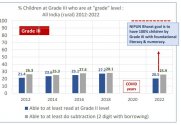Indian tech twitter now suspecting Chinese moles responsible for India's slow innovation drive.
What do said moles do? Do they expose the truth about Indian innovation on Twitter?
Indian tech twitter now suspecting Chinese moles responsible for India's slow innovation drive.

The kids can't read and can't do mathI often say quality is more important than quantity. India is a good example.
View attachment 105350
India saw minimal gains among rural schoolchildren (where a majority of the population still lives) even before the pandemic.
The Indian tech migrants coming to the West are part of the top 1%. India's population may have overtaken China's, but in terms of human capital quality, it is decades behind. And it shows no signs of convergence.
How this will affect India's economic prospects is obvious.
The full report can be found here:
Didn't one of these new trains have an incident because people were mad that the trains were functionally the same as the old ones and started pelting it with rocks? Something about the new trains running at basically the same speed as the old ones and all that changed was the exterior.No one can stop the rise of the world's oldest and greatest civilization Bharat Jai hind.
Article on this?Didn't one of these new trains have an incident because people were mad that the trains were functionally the same as the old ones and started pelting it with rocks? Something about the new trains running at basically the same speed as the old ones and all that changed was the exterior.
The kids can't read and can't do math
It wasn't a big incident, just some broken windows. I was trying to find the article talking about how people were upset at the train speed, etc. but it was just something I had read in passing and I couldn't find the article again.Article on this?
Here's the average speeds of Vande Bharat trains in India
1) New Delhi-Varanasi Vande Bharat Express has the top average speed of 95 kmph
2) Mumbai Central-Gandhinagar runs at an average speed of 84 kmph
3) New Delhi-Shri Mata Vaishno Devi Katra Vande Bharat Express runs at 82 kmph
4) New Delhi-Amb Andaura runs at an average speed of 79 kmph
5) Chennai-Mysuru Vande Bharat runs in a range from 75-77 kmph
